“Time is the school in which we learn, time is the fire in which we all burn.”—Delmore Schwartz
Density Training
Eighteen years ago, when I began my kettlebell journey, I also started relying on the clock to manage my training. Specific work-to-rest ratios were my foundation. When renowned wrestling and strength coach Ethan Reeve posted on a forum about his density training program around the same time, I immediately gravitated towards it. Coach Reeve’s strategy was an every-minute-on-the-minute approach that progressively added density, compressing a given amount of work into less time. I was hooked, and you can see this density training approach for the snatch test in my SFG Preparation articles.
In fact, I had laid out a very structured approach in my training to reach the Sinister standard using a very similar approach:
A formulaic increase in density can certainly be successful. But the failure of any training plan comes when we increase the workload on paper faster than our actual physiological progress.
How do we know when this happens? When we feel burned out and our progress hits a wall. That’s what happened to me in week 7 out of 11 on the plan above. I alluded to this in my “Knowing When Not to Grind” article, where I bumped my Sinister goal from 2018 to 2019.
Ditching the Clock: Timeless Strategy
Serendipitously, in discussing my training and reviewing the recently released Simple & Sinister 2.0, Pavel revealed his Timeless strategy to me. At first, I was reticent. The very idea of not having set work-to-rest ratios actually confused me—I found this very revealing. So, in January of 2019, I set myself on a Timeless attempt at Sinister.
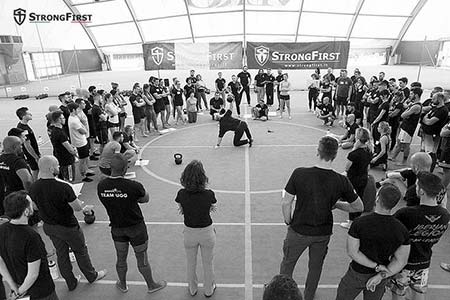
What is Timeless? Without revealing the full discussion in S&S 2.0, it is using the ‘talk test’ to gauge recovery between sets, and tracking the total time required to accomplish the goal sets and reps. For Sinister, this means 10 sets of 10 reps of one-arm swings, with the 48kg kettlebell.
My first attempt took 23 minutes and 50 seconds. Just to remind you, the goal is 5 minutes. While this might not seem an auspicious beginning, I was thrilled. Why? Because I felt great coming out of that session, versus the beat-up feeling from my previous structured attempts.
Using the Timeless approach, I adopted a new plan, alternating between sessions of either 48kg one-arm swings for 10 sets of 10 reps (100 total reps), or 56kg two-arm (and some one-arm) swings for 15 sets of 5 reps (75 total reps). I included one or two rest days between sessions.
Observations of note:
- When I had the chance to be consistent, I made quick progress;
- I left these sessions feeling great, without the burn or ‘beat-up’ feelings I had when pushing the density;
- Get-ups were also trained in a Timeless fashion and quickly made the required timeframe;
- Travelling away for work several days at a time resulted in temporary setbacks, proportionate to the length of the trip;
- Partway through, I started tracking the halfway point on the 48kg sessions, which made it easier to see when I pushed too hard in the first half of a session;
- I lacked a waviness to the routine, spending too much time with only the 56kg and 48kg—see my article, “Ride the Wave”;
- Variations in the 56kg times were due to travel and mixing in different amounts of one-arm swings, which greatly increased the impact of those sessions.
At this point, I had to shift my training focus to prepare for teaching at an SFG Level II. I will also explain in a future article why I did not return to my Sinister training in 2019.
Timeless in Other Goals
In case you were wondering if the Timeless strategy can be applied to other goals, I have had two recent students complete their snatch test using the same principle in different ways. Thank you to Jeff Turner SFG and Josh Jewett SFG for letting me share their plans.
To return to the original quote that started the article, the school of time has taught me some great lessons by searching for Timeless. As laid out in Pavel’s recent book, The Quick and the Dead, the “fire in which we burn” can be either time or the burn of training. To ensure I don’t burn out, Timeless will be a new foundation for my training moving forward.
Do you think you can find Timeless? Begin by reading Simple & Sinister 2.0, and then see if you can turn away from training by the clock in every session. Join us on the StrongFirst forum to share your results.
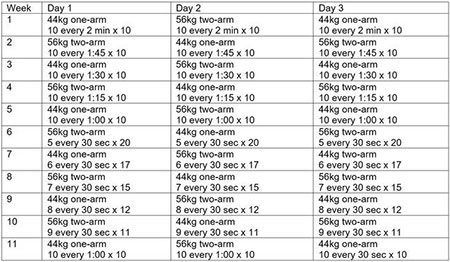
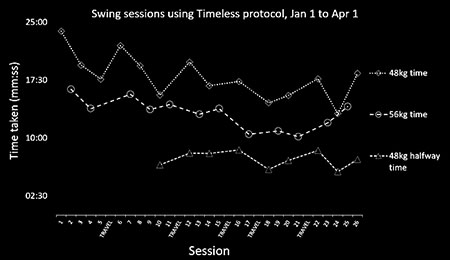
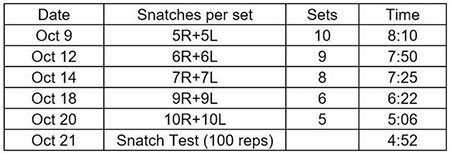
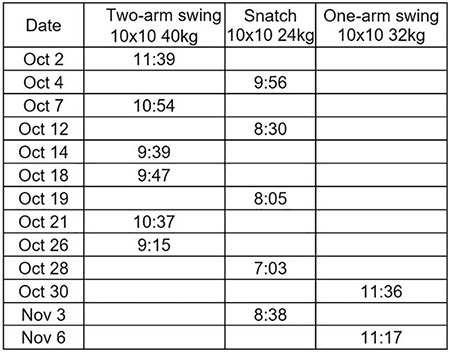
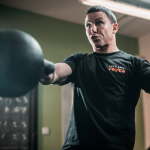
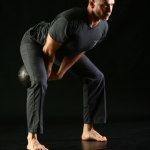






This paradigm leads me to think that it is best to measure overall time to complete a routine within a talk-test framework; the talk-test being the higher principle.
If Power = Work/time then if I can measure my progress in power. That is, 4 weeks later doing the same workout i have done it in half the time.
I have almost never paid attention to the clock since starting S&S early 2016. The talk test is mentioned in the first edition of the book, and I used it as my guide. In any case, I work so hard in my S&s sessions, and I tend to push the weight a bit so that compressing the rest times more than what felt natural actually seemed/seems a bit dangerous, to tell you the truth.
I think of clocks as highly artificial contraptions anyhow. My body is my own clock.
Amazing article!
Great article Brett. That feeling fresh after training mentality has been game changer for my consistency too. And overall doing each set when fresh makes training much simpler and more enjoyable too.
Sauli,
Feeling good feels good (to use the old saying).
Thanks.
Visiting this forum is always refreshing. New ideas. New approaches. Learning from the best!
Thank you Jawad